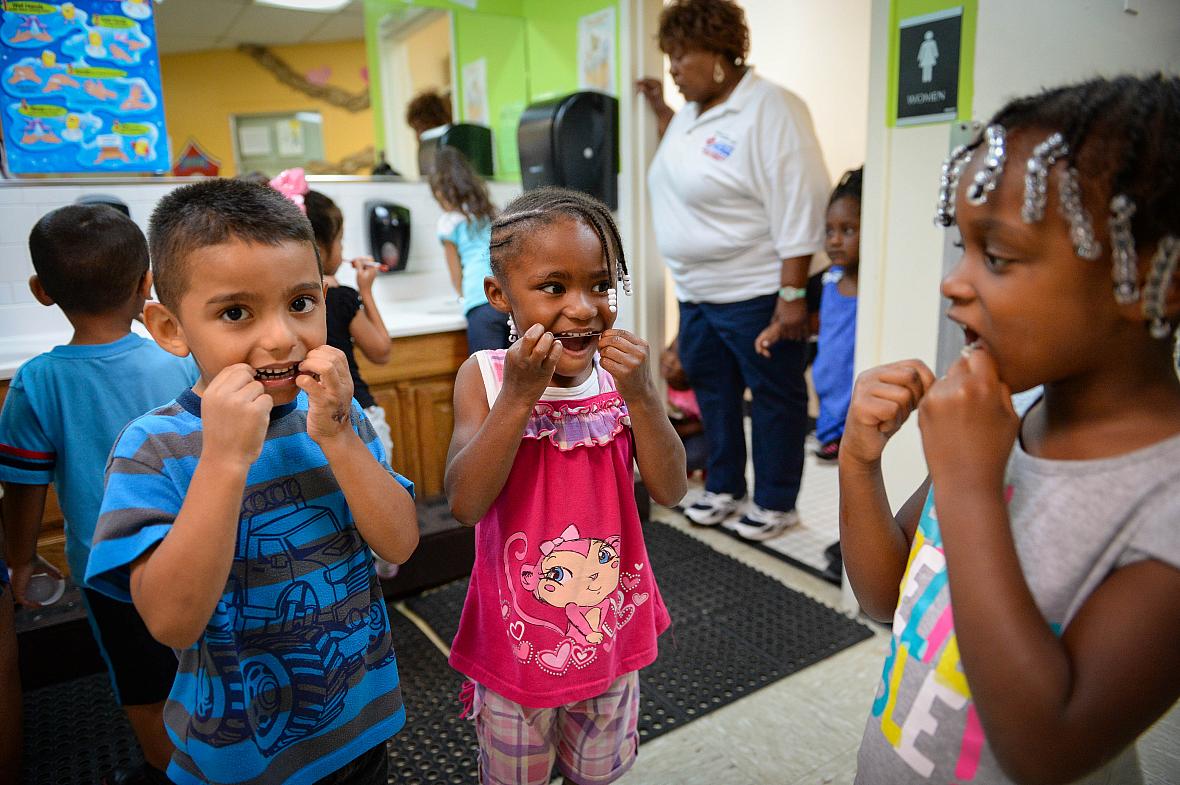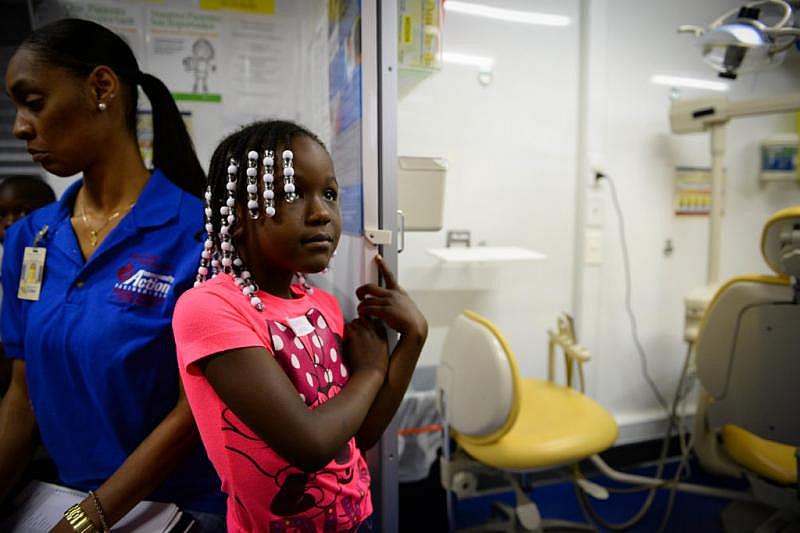In Florida, local coalition fights back against dental disease
Maggie Clark’s reporting on Florida’s Medicaid program for children was undertaken as a project for the Dennis A. Hunt Fund for Health Journalism, a program of the University of Southern California Center for Health Journalism.
Other stories in the series include:
Medicaid in Florida: 2 million kids. $24 billion battle.
Fighting for care in Florida's Medicaid system
An impossible choice: Doctors torn between patients and Florida's Medicaid system
2 Million Kids' series spurs support and quest for more data
Medicaid settlement: Florida will work harder to ensure health care for children

Felix Perlata, 4, Alani Waiters, 5, and Cymia Martin, 4, floss their teeth before heading back to class. Staff Photo/Rachel S. O'Hara
BRADENTON — Michelle Shoates stood on her tiptoes and twisted anxiously as she waited for the dentist to call her name.
Though the five-year-old had gotten her teeth cleaned on the dental bus before, she was still nervous.
Would the dentist be friendly? Would it hurt?
Michelle probably doesn’t know it, but she is one of the lucky ones.
Because she’s enrolled at Morton Clark Head Start preschool in Bradenton, she is one of 602 Manatee County preschool children who see a dentist at least once a year, as part of a partnership between MCR Health Services, a large low-income health center in Manatee County, and the Manatee County Head Start program, a federally subsidized preschool program for children living in poverty.
Her Medicaid insurance covers the cost of the visit, and a dentist from MCR Health Services treats her in a mobile dental bus parked in the school parking lot.
Once she steps on the bus she becomes a patient of MCR Health Services, with access to any of the health system’s medical providers.
The other 10,000 Manatee County children under age 6 who have Medicaid coverage and are not enrolled in Head Start, however, rely on their parents to find a dentist who will take their insurance.
Most kids go without any dental care. The consequences of missing out on oral health care last a lifetime.
Tooth decay is the most common childhood disease in the U.S., and disproportionately affects low-income children.
It also is the leading cause of absence for students all across the country. Students with dental pain miss more school days and have lower school performance than children without dental problems, a 2008 study of more than 2,100 North Carolina students found.
§
In Manatee County, the lack of dental care was creating a crisis for children — and the chief witnesses were school nurses.
Michelle Shoates, 5, looks on from the outside of the patient room as she waits to be seen by the dentist on the dental bus. Staff Photo/Rachel S. O'Hara
“As school nurses, we’re the ones who see the kids crying in the clinic,” said Sue Troxler, health services specialist for the Manatee County School Board. “They have dental pain, abscesses, they can’t eat and drink and they certainly can’t learn.”
The nurses knew that dental problems were a leading cause of absence for their public school students, and pursued partnerships with Manatee Technical College and local dentists willing to provide free dental care. But they still had trouble ensuring that parents could make it to their children’s appointments.
Missed appointments were a key factor in MCR Health Services’ decision to seek grant funding to purchase a mobile dental clinic to drive to rural and under-served communities.
“Lack of transportation and inconsistent work schedules kept many parents from bringing their kids to a follow-up dental visit,” said Toni Rosier, mobile health coordinator for MCR Health Services.
“So we thought, why not take the care to them?”
In 2012, MCR Health Services was awarded a $300,000 grant from the Florida Blue Foundation to purchase a mobile dental van and the fixed equipment inside.
In 2013, the bus, staffed with a pediatric dentist and two hygienists, parked at its first site, a Head Start preschool.
The choice made sense: dentists from MCR Health had already been visiting the Head Start programs and conducting exams wherever they could find a space.
Head Start and Early Head Start preschools, which offer federally-subsidized programs for low-income children starting as young as six weeks old, also are responsible with connecting their students with medical and dental care.
The following year, the new van route expanded to include a few elementary schools in underserved areas. When the dentists and hygienists got there, they were surprised at the level of dental disease they found.
“We started off targeting second-graders, but when the dentists started doing exams, they were seeing so much decay in the second-graders that they told us, ‘We have to start younger,’” said Dr. Sheila Halpin, the Manatee County Schools Title I specialist.
They should not have been surprised. More than three times the percentage of third-graders from the lowest-income Florida families had untreated tooth decay than did their higher income peers, according to a study from the Florida Department of Health.
Florida ranked 11th-highest in the nation in the percentage of third-graders with untreated decay, the study found.
Faced with this challenge, Dr. William Colgate, MCR Health Services’ senior vice president of accreditation and quality, found that Florida had no statewide policies to tackle the issue. So the MCR Health Services team, along with the school district and Head Start preschools, took on the problem themselves.
Having now established a strong foothold in the Head Start preschools and the public schools, the MCR Health Services dental bus is traveling to migrant labor camps, community events and reaching out to private daycares, which Rosier says are still reluctant to have the dental van come visit.
“Private daycares still don’t see the need to have dental visits for their toddlers and young children,” Rosier said. “We’re hoping that by working to educate our entire community, we’ll start to see those private preschools come around to the idea.”
Part of that education, Rosier said, involves raising awareness about the harm of feeding children food with too much sugar or leaving bottles in babies’ mouths while they are sleeping. A high-sugar diet provides the perfect opportunity for dental disease to permeate and erode a child’s teeth and gums.
§
Educating children and parents on oral health care is part of the everyday curriculum at Morton Clark Head Start in Bradenton.
Every day after both breakfast and lunch, Ms. Milton’s pre-kindergarten class of four-and-five-year-olds forms a single-file line and takes the short trip from their classroom to the bay of sinks just outside the preschool’s bathrooms. Their other teacher, Ms. Aguilera, carries a peg board filled with 19 labeled toothbrushes for the kids to use.
As the preschoolers march down the hall, they sing “brush, brush, brush your teeth,” to the tune of Row, Row, Row Your Boat and wiggle excitedly at the activity ahead of them. When five-year-old Yesenia Quezada-Perez finished brushing her teeth and rinsing her mouth, she flashed a shiny smile to her teacher.
“All clean!”
The daily teeth brushing is just one way the preschool program makes sure the children develop good oral health habits early so they stand a better shot of beating the tough odds facing them as children growing up in low-income families.
“We know that once young children have developed dental disease, you’re in defense mode and not able to do much prevention,” Colgate said. “But if you can educate the children and their parents early on about the importance of oral hygiene, that’s going to carry just as much weight as putting on sealants or treating cavities.”
Back on the dental bus, Michelle sat still in the exam chair as hygienist Faith Carnes gently touched her teeth and brushed them with fluoride toothpaste.
“You’re doing such a good job brushing your teeth,” Carnes told Michelle as she used a suction wand to remove the excess toothpaste from the girl’s mouth.
The dental visit puts Michelle one step closer to a future without cavities or other oral health problems that can get in the way of her school success and future job prospects.
When they were all done, Michelle walked confidently off the bus, the beads in her hair swishing back and forth as she and a teacher’s aide walked hand-in-hand back to her classroom.
Dental worries gone, it was time for another important part of the day — recess.
[This story was originally published by the Herald-Tribune.]
Photos by Rachel S. O'Hara/Herald-Tribune.

